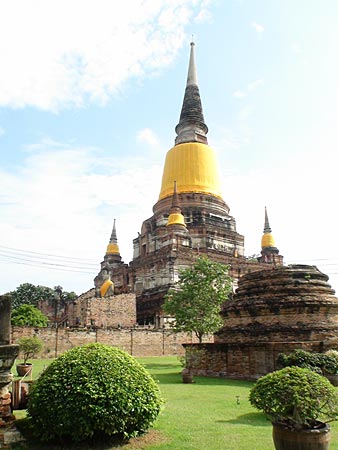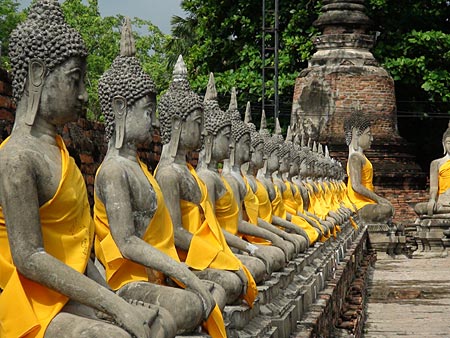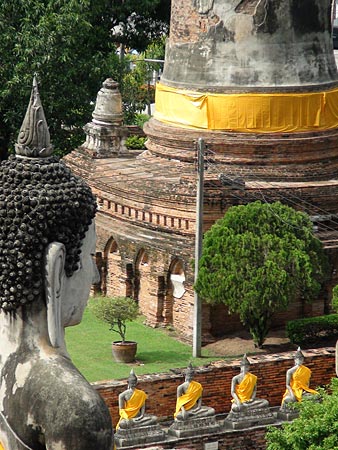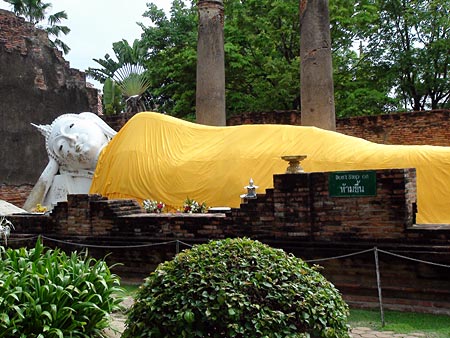Wat Yai Chai Mongkol (Mongkhon), Ayutthaya
Video of Wat Yai Chai Mongkol at bottom of this page.
Wat Yai Chai Mongkol (or Mongkhon) is located a few kilometers southeast of Ayutthaya (island). You'll have to cross the Pridithamrong bridge out of the city. It obviously is one of the major temples in the Ayutthaya area, and both tourists and local worshippers visit the wat. Logistically, visiting this temple can be well combined with a visit to Wat Phanan Choeng (open till 5 P.M.).
If you do combine the two, it probably is slightly better to visit Wat Phanan Choeng first, since the attraction there is in-doors. Wat Yai Chai Mongkol stays open till 6 P.M. and you can take better pictures if you come a bit later in the afternoon.

The impressive stupa (chedi) at Wat Yai Chai Mongkol, Ayutthaya
Historical Notes
Wat Phra Chao Phya-thai. populary known as Wat Yai Chaimongkol, is situated to the southeast of the city. The large chedi there can be seen from a great distance.
It was built by King U-thong in 1357 A.D. for the use of the monks who had returned from Ceylon after studying under Phra Vanarat Maha Thera. This body of monks was known as the Pa Kaeo Sect. So this monasteny was originally known as Wat Pa Kaeo. The monks of this sect were engaged mainly in meditation.
Many people who respected the monks joined the order. The king conferred the title of Somdej Phra Vanarat on the head of the sect and appointed him to the position of Patriarch on the Right Hand Side.

Rows of Buddha Images around the central stupa. Wat Yai Chai Mongkol
Since it was the place where the patriarch stayed, the monastery was named Wat Chao Phya-thai which means The Temple of the Supreme Patriarch.
Various royals and princes sought advice here during the Ayutthaya period.
In 1592 A.D. during the reign of King Naresuan the Great, the Burmese led an army to try to subjugate Ayutthaya. King Naresuan resisted the invasion and fought on elephant back with the Burmese leader at the district of Nong Sarai in the province of Suphanburi, and was victorious.
On that occasion, King Naresuan's army was not able to inflict greater losses on the Burmese because many of his regiments did not come to reinforce him in time.
The King wished to execute the officers of those regiments at the conclusion of the war, but Patriarch Vanarat begged the King to pardon them and advised him to build chedis in memory of his great victory.

View from the Chedi at Wat Yai Chai Mongkol, Ayutthaya
So King Naresuan built one on the scene of the singlehanded combat at Nong Sarai in Suphanburi, and a bigger one on the premises of Wat Chao Phyathai. This second chedi built by King Naresuan was named Phra Chedi Chai Mongkol, or Chedi of the Auspicious Victory, and it was popularly known as Phra Chedi Yai, or the Great Pagoda.
So. later on Chao PhyaThai came to be known also as Wat Yai Chai Mongkol. The top of this chedi is visible to visitors from Bangkok as soon as they enter the boundary of Ayutthaya.
(historical notes from documents by the Department of Fine Arts)

Reclining Buddha Image at Wat Yai Chai Mongkol
More and larger pictures of Wat Yai Chai Mongkol

